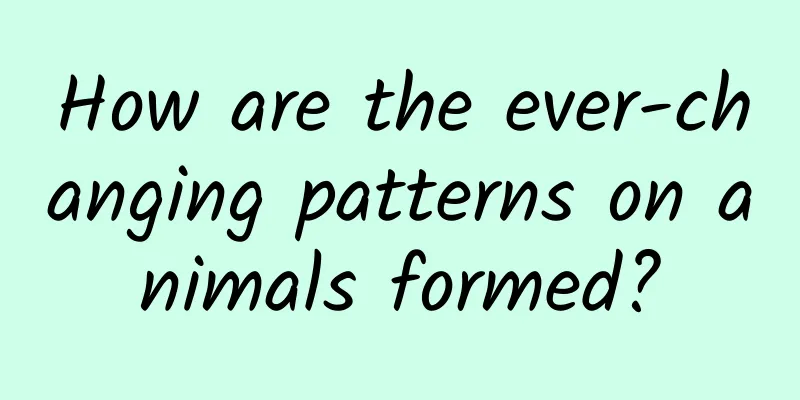How are the ever-changing patterns on animals formed?

|
Abstract: The physical processes used to remove dirt from dirty laundry may also play a role in explaining how patterns form in animals. Author: Principle From leopard spots to zebra stripes to poison frog spots, nature is full of patterns. These patterns on animals are more than just decorative, they actually perform a variety of biological functions, such as temperature regulation, camouflage, attracting mates and sending warning signals. However, scientists still lack a complete understanding of how these patterns are formed. In a study published November 8 in the journal Science Advances, a team of researchers demonstrated that the physical processes used to remove dirt from dirty laundry may also play a role in explaining how these patterns form. Turing's reaction-diffusion mechanism When it comes to patterns on animals, we have to mention a scientist, the famous scientist Alan Turing. Most people's impression of Turing is that he made great contributions to code breaking and artificial intelligence, but in fact he has also been engaged in research in biological mathematics for a long time. In 1952, he published a very visionary paper. In this paper, he proposed a very simple model to explain how patterns such as stripes, spots and scales on animals are formed. Turing's model is called the reaction-diffusion mechanism, and it's a very simple model that requires only two interacting agents, an activator and an inhibitor. The activator starts some process, such as the formation of the spot, and promotes its own production; the inhibitor prevents either of these effects from happening. We can use a scenario described by Professor James Murray of Oxford University to understand Turing's theory. Imagine a field of hay with a large number of grasshoppers. If a few random points of the grass are ignited, without water to suppress the flames, the fire will spread and evenly burn the entire field. However, if this happens within the framework of the Turing mechanism, the heat from the spreading flames will cause the grasshoppers to sweat and produce enough moisture to make the surrounding grass wet, preventing the fire from spreading to wet areas. In this way, the scorched area will be confined to a limited area. In this scenario, fire is an activator and grasshoppers are an inhibitor. However, although the mechanism proposed by Turing can produce a pattern, the problem is that diffusion cannot produce a pattern with clear outlines. This is like when we drop ink into water, the ink will spread in all directions with a fuzzy outline. A process similar to washing clothes To further unravel the mystery of the Turing pattern, the scientists in the new study focused on a phenomenon called diffusiophoresis, which occurs when molecules in a liquid move in response to a change in the liquid, such as an increase or decrease in concentration, which speeds up the movement of other types of molecules in the same environment. In fact, in daily life, when you wash clothes, you benefit from diffusion electrophoresis. If you rinse clothes soaked in soap with clean water, or rinse clothes soaked in soapy water, which method do you think will remove dirt faster? A 2018 study showed that the answer is the former. This is because when soap diffuses from the fabric into water with a lower soap concentration, the movement of soap molecules can carry away the dirt; while when clothes soaked in soap are placed in soapy water, the lack of concentration difference will cause the dirt to stay in place. To see if diffusion electrophoresis also plays a role in the formation of animal patterns, the researchers simulated the complex and clear pattern of the boxfish, which is made up of purple dots, each surrounded by a distinct hexagonal yellow outline. The researchers first simulated the purple and black hexagonal pattern on the boxfish skin using only Turing equations. It turned out that the computer generated an image composed of fuzzy purple dots and fuzzy black outlines. In other words, the reaction-diffusion model can capture the essence of the pattern, but it cannot reproduce the pattern with clear outlines. Then, the researchers considered the role of diffusion electrophoresis and modified the equations. They found that the reaction-diffusion simulation with diffusion electrophoresis added formed a pattern similar to that seen on the boxfish. The top image shows a male boxfish. The lower left image shows a close-up of the hexagonal pattern on the boxfish; the lower middle image shows the pattern simulated based on Turing's reaction-diffusion theory; the lower right image shows the result of a reaction-diffusion simulation with diffuse electrophoresis added. Image/The Birch Aquarium/Scripps Institution of Oceanography and Benjamin Alessio Their theory suggests that as the chemicals diffuse through tissues, they drag along pigment-producing cells by diffusion electrophoresis, just as soap pulls away dirt from clothes. These pigment cells form sharply defined spots and streaks. Diffusion electrophoresis is underestimated This new study suggests that diffusion electrophoresis may be an underestimated role in pattern formation. Furthermore, in addition to patterns in animals, Turing patterns are actually critical for processes such as embryonic development and tumor formation. Therefore, diffusion electrophoresis may play an underappreciated but extremely critical role in these natural processes. Moreover, understanding the role of diffusiophoresis in pattern formation could help scientists develop materials that could be used in fields such as photonics, lab-on-a-chip devices and biotechnology. Overall, this discovery of the role of diffusiophoresis in pattern formation provides a foundation for future research and could have an impact on numerous fields. This article is a work supported by Science Popularization China Starry Sky Project Author: Principle Reviewer: Ye Sheng, Professor of Beijing University of Aeronautics and Astronautics Produced by: China Association for Science and Technology Department of Science Popularization Producer: China Science and Technology Press Co., Ltd., Beijing Zhongke Xinghe Culture Media Co., Ltd. |
<<: What are the benefits of soaking your feet regularly?
>>: Going inside rocks to explore the scientific mysteries of fluid inclusions
Recommend
Three pieces of silk fabrics recreate the shock of the Silk Road!
Spanning 5,000 years, more than 210 pieces/sets o...
NEX dual-screen mobile phone experience: vivo's black technology, it's impossible to be low-key, the strength really doesn't allow it
Starting with the NEX with a pop-up camera, vivo ...
In addition to Alipay's five blessings, there are billions more! A complete guide to picking up money from the Spring Festival red envelopes
[[380950]] In the past two days, I believe everyo...
Efficient employment class for emotional counselors, achieving a side job with a monthly income of 50,000+ [audio course]
Efficient employment class for emotional counselo...
Zxing scan code example
Source code introduction An example of Zxing scan...
Is it expensive to produce a Kunming cosmetics mini program? Kunming cosmetics mini program production cost and process
In order to better penetrate into various industr...
How to do content marketing well and let users come to you!
When making a product, content should be added to...
Analysis of Xiaohongshu and Mogujie's competitive products
Xiaohongshu , Mogujie and What’s Worth Buying are...
[Smart Agriculture Diagram] One picture reveals the secret! How safe are genetically modified foods?
...
Chen Pan, "Yamaha: Why can a century-old company maintain its endless innovative vitality? 》
Chen Pan's "Yamaha: How can a century-ol...
What would you most like to do if it snows? Do science popularization! | Expo Daily
Your best "insider" in the scientific c...
Which platform is suitable for financial loan advertising? How to place financial loan advertisements!
The 618 carnival has been going on for 3 consecut...
Apple releases second beta of iOS 8.3 to developers
Apple released the second beta of iOS 8.3 to deve...
Tesla's free charging service will end next year and will be replaced by a points-based system
Lifetime free charging is a major selling point o...
Want to get the most active and high-quality users? You should know these promotion methods
App stores are the main platform for app promotio...









